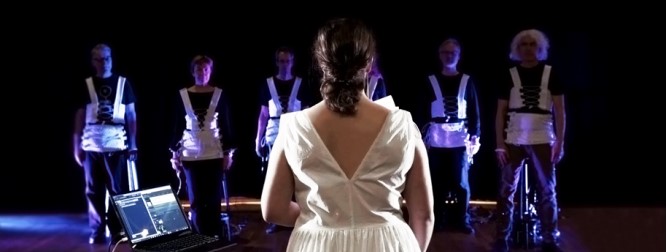3 Voices // SymbioSing (2020-2022)

As a vocalist, I have been fascinated with the “making physical” of my voice (an invisible, untouchable instrument) for over a decade. The voice has a tangible physicality. I can feel where the voices of other people are resonating in their bodies—through my own bones, muscles and skin—even when their bodies are not physically with me. They, and their voices, are physically present despite their absence. But how can I let someone else—or even the whole audience—feel my untouchable instrument? This project examines touch as a transgressor of the boundaries of the body.
In 1982, Morton Feldman composed a piece of music for American vocalist Joan La Barbara, who had requested an orchestral work. Instead, he sent her a work for three voices to be sung by a single performer. This music—Three Voices—is a séance across time and space, with the 2 pre-recorded voices from the past singing with the present, live voice. Past meets present, and the ghostly voices sing together with the live one, across time. Textures collide and microtones beat, forming an air-based substance that oscillates in the singer’s mouth. In this project, we aimed to explore the possibility of evoking such somatic experience in the non-singing bodies of the audience.
We aimed to augment Feldman’s ghostly voices, making them physical through an accompanying haptic score. We did this by first developing body-compliant sensing mechanisms such as stretchable worn sensors, and in-mouth implantable sensors, that can together capture the physiology behind the somatic experience of singing with the help of machine learning. To convey this experience to another person’s body, we used a soft haptic feedback mechanism integrated with the sensing system within a single fiber structure. Our integrated fiber-based soft robotic system allowed us to craft a programmable garment through fabric formation techniques, in which the wearer can experience another person’s voice through the wearer’s own body via micro- and meso movements in the robotic fabric patterns. We harnessed the intimacy of close-fitting sensing and actuating fabrics to extend the somatosensory perception of the body, making it possible to identify someone else’s singing body as one’s own.
How can we “make physical” the subtle movements of singing, and transpose these nuances into tactile echoes that modulate and reverberate inside someone else’s body? We envisage that harnessing haptic technology will open up a whole new pathway of hearing the music, feeling the voice as if it were coming from one’s own body -- even if only momentarily. We anticipate this immersive performance piece will completely reframe the conventional listening experience and perhaps create an entirely new hearing of Feldman’s score, yet one congruent with its musical communion across time and space.